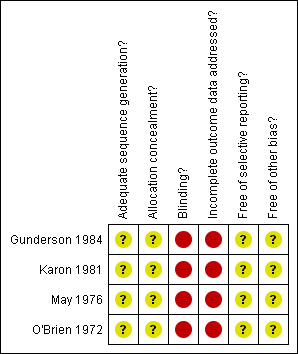Contenido relacionado
Revisiones y protocolos relacionados
Glenn E Hunt, Nandi Siegfried, Kirsten Morley, Carrie Brooke‐Sumner, Michelle Cleary | 12 diciembre 2019
Anne‐Marie Bagnall, Mark Fenton, Jos Kleijnen, Ruth Lewis | 24 enero 2007
Lucy A Buckley, Nicola Maayan, Karla Soares‐Weiser, Clive E Adams | 14 abril 2015
Rachel Ruddy, Kim Dent‐Brown | 24 enero 2007
Jacqueline Sin, Debbie Spain, Marie Furuta, Trevor Murrells, Ian Norman | 24 enero 2017
Marina Dieterich, Claire B Irving, Hanna Bergman, Mariam A Khokhar, Bert Park, Max Marshall | 6 enero 2017
Uzuazomaro Okpokoro, Clive E Adams, Stephanie Sampson | 5 marzo 2014
Benno Hartung, Stephanie Sampson, Stefan Leucht | 6 marzo 2015
Max Marshall, Ruth Crowther, William Hurt Sledge, John Rathbone, Karla Soares‐Weiser | 7 diciembre 2011
Siobhan Reilly, Charley Hobson-Merrett, Bliss Gibbons, Ben Jones, Debra Richards, Humera Plappert, John Gibson, Maria Green, Linda Gask, Peter J Huxley, Benjamin G Druss, Claire L Planner | 7 mayo 2024


























